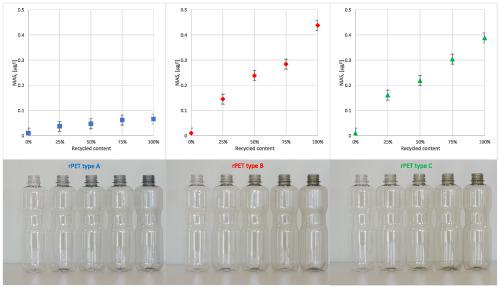当前位置:
X-MOL 学术
›
Packag. Technol. Sci.
›
论文详情
Our official English website, www.x-mol.net, welcomes your feedback! (Note: you will need to create a separate account there.)
Effect of recycled content and rPET quality on the properties of PET bottles, part II: Migration
Packaging Technology and Science ( IF 2.6 ) Pub Date : 2020-08-03 , DOI: 10.1002/pts.2528 Eggo Ulphard Thoden van Velzen 1, 2 , Marieke T. Brouwer 1, 2 , Carina Stärker 3 , Frank Welle 3
Packaging Technology and Science ( IF 2.6 ) Pub Date : 2020-08-03 , DOI: 10.1002/pts.2528 Eggo Ulphard Thoden van Velzen 1, 2 , Marieke T. Brouwer 1, 2 , Carina Stärker 3 , Frank Welle 3
Affiliation

|
Polyethylene terephthalate (PET) bottles were produced from three types of recycled PET (rPET) with four levels of recycled content. The migration of substances from these bottles to water was studied. Several migrated substances were detected. The migrated amounts of acetaldehyde and ethylene glycol complied with the limits given in the food contact material (FCM) legislation. Migration of 2‐methyl‐1,3‐dioxolane was below the limit of 10 μg·L−1, which is conventionally applied for non‐intentionally added substances (NIAS) not classified as ‘carcinogenic’, ‘mutagenic’ or ‘toxic to reproduction’ (CMR). Limonene, acetone, butanone and furan were also detected as migrants, of which limonene is a natural fragrant, and the other three are probably residues from solvents used to clean and protect the mould at the small‐scale production facility. Finally, benzene and styrene were also found as migrants from rPET. These migrants appear to originate from heat‐induced reactions within the PET matrix, which involve contaminants. The formation of benzene in rPET is attributed to polyvinylchloride as contaminant. The migrated amounts of benzene from the PET bottles with recycled content to the water simulant are relatively small (0.03–0.44 μg·L−1) after 10 days at 40°C. Consequently, the margin of exposure is 3.105–8.106. Hence, the level of concern for the public health is low, and the migrated amount represents a low priority for risk management. The FCM legislation demands a risk assessment for migrating NIAS. Depending on the underlying data and exposure scenario, different threshold limits in the food can be derived which can still be considered as safe.
中文翻译:

回收物含量和rPET质量对PET瓶性能的影响,第二部分:迁移
聚对苯二甲酸乙二酯(PET)瓶由三种类型的回收PET(rPET)和四种回收含量制成。研究了物质从这些瓶子向水的迁移。检测到几种迁移的物质。乙醛和乙二醇的迁移量符合食品接触材料(FCM)法规中规定的限制。2-甲基-1,3-二氧戊环的迁移低于10μg·L -1的极限通常用于非故意添加的物质(NIAS),未归类为“致癌”,“致突变”或“生殖毒性”(CMR)。柠檬烯,丙酮,丁酮和呋喃也被检测为迁移物,其中柠檬烯是天然香气,另外三种可能是溶剂的残留物,这些溶剂是在小规模生产设施中用于清洁和保护模具的。最后,还发现苯和苯乙烯是rPET的迁移物。这些迁移物似乎源自PET基质内的热诱导反应,其中涉及污染物。rPET中苯的形成归因于聚氯乙烯作为污染物。苯从具有再循环含量的PET瓶向水模拟物的迁移量相对较小(0.03-0.44μg·L -1)在40°C下放置10天后。因此,暴露的余量为3.10 5 –8.10 6。因此,对公众健康的关注程度很低,迁移量代表着风险管理的低优先级。FCM立法要求对迁移NIAS进行风险评估。根据基础数据和暴露情况,可以得出食品中不同的阈值限制,仍然可以认为是安全的。
更新日期:2020-08-03
中文翻译:

回收物含量和rPET质量对PET瓶性能的影响,第二部分:迁移
聚对苯二甲酸乙二酯(PET)瓶由三种类型的回收PET(rPET)和四种回收含量制成。研究了物质从这些瓶子向水的迁移。检测到几种迁移的物质。乙醛和乙二醇的迁移量符合食品接触材料(FCM)法规中规定的限制。2-甲基-1,3-二氧戊环的迁移低于10μg·L -1的极限通常用于非故意添加的物质(NIAS),未归类为“致癌”,“致突变”或“生殖毒性”(CMR)。柠檬烯,丙酮,丁酮和呋喃也被检测为迁移物,其中柠檬烯是天然香气,另外三种可能是溶剂的残留物,这些溶剂是在小规模生产设施中用于清洁和保护模具的。最后,还发现苯和苯乙烯是rPET的迁移物。这些迁移物似乎源自PET基质内的热诱导反应,其中涉及污染物。rPET中苯的形成归因于聚氯乙烯作为污染物。苯从具有再循环含量的PET瓶向水模拟物的迁移量相对较小(0.03-0.44μg·L -1)在40°C下放置10天后。因此,暴露的余量为3.10 5 –8.10 6。因此,对公众健康的关注程度很低,迁移量代表着风险管理的低优先级。FCM立法要求对迁移NIAS进行风险评估。根据基础数据和暴露情况,可以得出食品中不同的阈值限制,仍然可以认为是安全的。



























 京公网安备 11010802027423号
京公网安备 11010802027423号